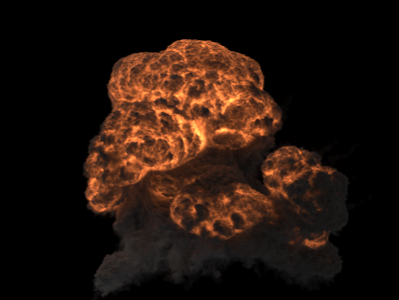Rendering Parameters
Rendering
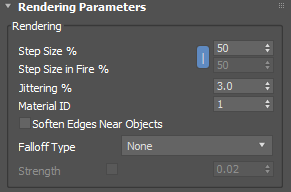
Step Size % - This setting affects rendering quality. The selected value defines a ray marching stride based on a percentage of the voxel size. With smaller values, more steps will be needed for shading to achieve a high quality output. But, for example, you don`t need to go very low for uniform and transparent smoke as there`s no detail in it. You might want to use lower values in connection with Fluid Mapping usage.
Step Size In Fire % - This spinner specifically affects the rendering quality in fire. It can be linked to the default step size, or set separately if you need more accuracy in rendering fire. Due to the nature of fire, you will need a smaller step size for fire than for smoke.
Jittering % - This parameter adds spatial randomness to the sampling. With a high step size you might get noise-like effects, but with a finer step size you will gain soft, blurred smoke.
Material ID - This effects channel is used if you want to apply Rendering Effects to FumeFX fluid. This will affect each pixel that contains FumeFX rendered volume unless another compatible volumetric is occluding it.
Soften Edges Near Objects - By default, FumeFX assumes that all objects affecting simulation will remain visible in the rendering, so it alters the Fire and Smoke values accordingly before saving. This is intended to improve the visual output of the rendering; however, if you choose to render without those objects, this default action may make the Fire and Smoke near those objects appear coarse or aliased. In such instances, enabling this Soften Edges option will help to soften these edges.
Falloff Type - This selection defines the method that will be used to attenuate smoke and/or fire near the edges of the simulation area.
Strength - This adjusts the strength of falloff.
Motion Blur

To be able to use motion blur caches must have velocities exported. Please note that Scanline renderer does not support motion blur of volumetric effect thus the end result will be inferior to Arnold or Redshift. In order for motion blur to work with Scanline renderer please make sure that Illumination Map is disabled
Duration - Motion Blur duration in frames. For VRay and mental ray, this parameter is just the multiplier of duration parameters from the rendering dialog. Duration larger than 1 frame will result with incorrect motion blur.
Samples - Number of motion blur samples. With VRay or mental ray this parameter is not used.
Render Warps
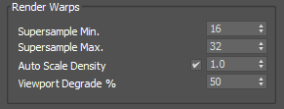
FumeFX supports various Space Warps that can affect FumeFX at render time. This tool gives artists lots of flexibility for post-simulation adjustments. Because Space Warps can significantly distort FumeFX volume, supersampling is used to lessen the effect of artifacts.
Supersample Min - Minimum number of samples.
Supersample Max - Maximum number of samples.
Auto Scale Density - Rendering output can be affected due to the volume change caused by Space Warp distortion. This option can keep similar rendering output when Render Warps are used.
Viewport Degrade - Because Render Warps require lots of computational power, you might want to use lower quality for GPU Viewport.
Gridless Advection

With fluid simulations the amount of detail is limited with memory and simulation time. A quick and efficient way to get additional detail from caches is to perform a so-called gridless advection at render-time.
Strength - The strength of the effect.
Type - Texmap option uses a 3D texture to displace the volume and create additional detail. This method is very good for static objects like clouds. Cached Velocites will use exported velocities and perform additional advection step at render time which will result in more detailed rendering.
Map - A 3D texture map (usually Perlin Noise) that can be used to displace volume.
Note: Gridless advection will not play well with illumination map.

This group of parameters allows user to create cinematic looking explosions with Scanline renderer and with the Arnold renderer in combination with maps.
Blur Width - Determines the blur width (in voxels) for the temperature channel.
Blur Levels - Temperature field can be blurred multiple times with each blur level doubling the width of blur filter.
Level Persistence - Determines the contribution of each successive blur level. With default value of 0.5, the first level will have contribution of 1.0, second level of 0.5, third level of 0.25 and so on.
Create Emission Mask - Enabling this option will create emission mask that is based on the smoke channel. When rendering with Arnold Standard Volume mask can be accessed by using the "EmissionMask" name inside the Volume Sample Float map.
Min Value - Minimum smoke value for the mask.
Max Value - Maximum smoke value for the mask.
|
|
|
|
|
Min 0.0 Max 0.075 |
Min 0.0 Max 0.125 |
Min 0.05 Max 0.2 |
Here is one example how to construct Arnold`s shader nodes in order to render explosions with emission mask and color ramp that is based on the temperature channel.
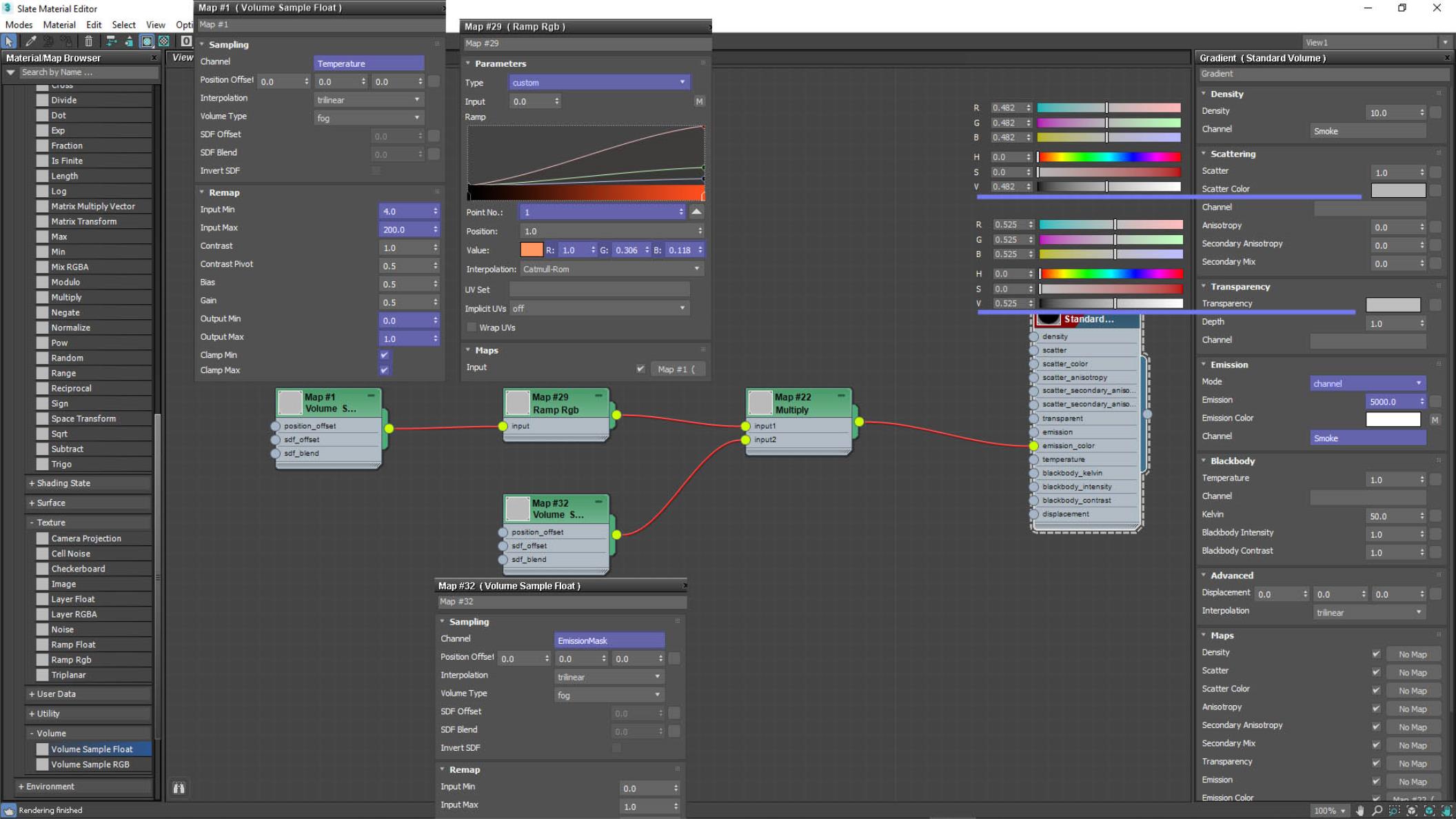
Volume Shading
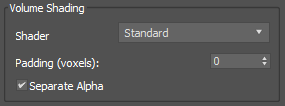
FumeFX supports specific shaders to render the visual data obtained through simulation. You can adjust the parameters of a shader to control the rendered appearance of your fiery effects.
Shader - Choose an available shader from this dropdown list. Currently, FumeFX offers three choices: Standard, Channel Data and FumeFX-Arnold Volume. When either of these shaders is chosen, a set of rollouts specific to the shader are displayed for manipulation.
Padding - This option will add voxels around the FumeFX bounding box to allow using displacement shader or similar. For example, one would like to use Arnold renderer and render FumeFX volume with noise displacement, but the grid is simply too small to include all the additional detail. In such situations, user is advised to increase the padding value until rendering result turns correct.
Separate Alpha - By default, FumeFX computes alpha channel in a different way than colors and transparencies used to blend fire and smoke during ray marching. This is useful for the Smoke Shader because changes in falloff values will not alter final alpha channel. It also allows for the Fire Shader to boost up alpha channel without changing final result. This however has a drawback. If you put a transparent object inside a fire, you will immediately notice rendering artifacts. In mental ray, artifacts could be visible if FumeFX grids overlap.
